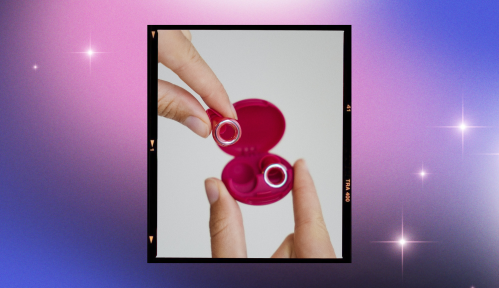I Went to the Eye Doctor for a Stronger Prescription, but the Problem Was Actually a Brain Disorder—and It’s on the Rise in Women My Age
A writer shares how she was diagnosed with idiopathic intracranial hypertension (IIH) and explores why IIH is on the rise in women like her.

I was first diagnosed as nearsighted around 12 years old. After years of secretly wanting to need glasses (my cool older brother had needed them since before I was born), I found myself struggling to see the characters on stage at a performance of Wicked on Broadway, so my parents took me to the eye doctor where, sure enough, I had mild myopia, or a slight distortion of vision from a distance.
Experts in This Article
professor of neurosurgery and chief of neuro-interventional surgery at North Shore University Hospital in New York
endovascular surgical neuroradiologist in the department of neurological surgery at NewYork-Presbyterian Queens and assistant professor of radiology in neurosurgery at Weil/ Cornell Medicine
Sensing my excitement, the ophthalmologist reminded me to only wear my glasses when looking at far distances—for example, the chalkboard at school or the television in our living room. Essentially, the more I wore them, the more my eyes would get used to them, he said, and I’d likely grow to need a stronger prescription.
Despite his best efforts, by the time I was old enough to drive, I needed to wear my glasses all the time (which, to be fair, likely would have happened anyway, as myopia has a strong genetic component and both my parents had it).
Throughout high school and college, I alternated between wearing my contacts and glasses. I was routinely getting eye exams not because my vision was changing so frequently, but because I loved getting new frames and wanted to make sure my lenses were up to date in them.
But then life got busy. I graduated college and started working as a beauty editor in New York City, and I didn’t have as much time for (okay, I didn’t make as much time for) myself as I used to. Over the next two or three years, my vision got worse and I knew I needed an updated prescription. But I never imagined the news I’d get the next time I stepped into an eye doctor’s office.
The first sign that something was wrong
A few years after college, something strange suddenly happened to my vision. Picture this: I’m at a backyard barbecue at my aunt’s house in New Jersey. It’s summer 2020, so we’re all social-distancing outdoors (but also so happy to be back together after months of indoor quarantining). She had moved just prior to the pandemic, so this was our first time seeing her new home. I’m sitting at the table on the back deck admiring the house when I notice the siding looks off—it doesn’t appear straight on the top of each panel.
I get up to take a closer look and as I’m approaching the house, the panel appears to flatten out. The best way I can describe it is that what should’ve appeared to be a flat, even line at the top of each panel of siding had a curve protruding from it, but as I got closer, the curve went away, almost like an optical illusion.
“Dang,” I thought to myself. “I really need to get my eyes checked.”
Finally in the fall, after some encouragement from my mom, I dragged myself (and mom) to an eye doctor appointment. At this point it had been quite some time since my last eye exam, so I went to a local doctor that was new to me, near my family’s home on Long Island.
When the doctor asked if I had any changes in my vision, I explained to her the visual distortion I had been seeing. She told me not to worry, but after running through a typical eye exam, not only did I need a new prescription, but the doctor noticed something else that gave her pause. She said my optic nerves looked enlarged and encouraged me to see a neuro-ophthalmologist for a second opinion, since the optic nerve is what connects the eye to the brain. The neuro-ophthalmologist that took my insurance at her practice wouldn’t be able to see me for a few weeks, so we made an appointment for good measure, but she suggested I try to get in somewhere else more quickly.
I kept my composure until we were out of the office, but then the panic set in. Having lost my father to metastatic brain cancer when I was 14, I was sure this was it for me. I am beyond blessed to have an amazing support system in my family, though, and my mom, aunt, and uncle hit the ground running looking for a neuro-ophthalmologist in my area on my plan. They came across Robert Rothstein, MD, who, after hearing about my symptoms, squeezed me in for an emergency appointment the following day.
Getting a name for my symptoms
Dr. Rothstein performed a comprehensive eye exam, agreed that my optic nerves seemed swollen, and suggested a diagnosis of papilledema, a condition defined by the Cleveland Clinic as “the swelling of both optic discs in your eyes due to increased intracranial hypertension,” or pressure around the brain.
Intracranial hypertension can be caused by head injury, stroke, a ruptured brain aneurysm, tumors, or even certain infections such as meningitis or encephalitis. Because pressure around the brain can be life-threatening, Dr. Rothstein immediately ordered a series of tests to determine the cause, including blood work to look for disease and infection, brain imaging to scan for tumors and abnormalities, and a lumbar puncture (or spinal tap) to check my levels of cerebral spinal fluid (CSF), the clear, watery fluid that surrounds and protects the brain and spinal cord.
The latter test was performed by Srikanth Boddu, MD, an endovascular surgical neuroradiologist in the department of neurological surgery at NewYork-Presbyterian Queens and an assistant professor of radiology in neurosurgery at Weil/Cornell Medicine.
Thankfully, the blood work and imaging came back clear. But the spinal tap showed that my CSF levels were elevated, and other tests showed that the large veins in my brain were narrowed and under pressure (a condition called venous sinus stenosis).
Together, these confirmed the diagnosis of intracranial hypertension, but because there didn’t appear to be an underlying cause, the diagnosis was updated to idiopathic intracranial hypertension (IIH), meaning “increased pressure on the brain of unknown origin.”
IIH was once called pseudotumor cerebri because its effects mimic those of a brain tumor. Common symptoms can include headaches, tinnitus (a whooshing or pulsing noise in the ears), and visual symptoms like I was having, but also blurring, floaters, and black spots. Headaches tend to be worse in the morning when you wake up and can get more intense when you lean forward. Some people experience additional symptoms, too, like dizziness, memory issues, cognitive impairment, and balance problems. In severe cases, the swelling of the optic nerve can cause vision loss, per the Mayo Clinic.
Although I was diagnosed with IIH at 27, I’ve struggled with headaches my whole life. Drs. Rothstein and Boddu have both said it’s possible I was dealing with symptoms of IIH long before my diagnosis.
“Many of my patients have been told ‘you are fine,’ ‘there’s nothing wrong with you,’ and ‘this is all just in your head.’ In fact, those doctors are correct—the problem is in the patients’ heads, it just didn’t get diagnosed!” —Srikanth Boddu, MD, endovascular surgical neuroradiologist
A growing problem
Penn Medicine reports that IIH affects approximately 2 in 100,000 people each year, making it a relatively rare condition. But that number increases significantly for women between the ages of 15 and 44 who are classified as having obesity, to 22 in 100,000 people (for what it’s worth, I fit that demographic).
And the numbers are on the rise. According to a February 2024 study in Neurology1, IIH is a rapidly increasing health care concern in the U.S., especially for Black and Hispanic women. And, sadly, the largest jump in prevalence in the past decade has been in girls ages 11 to 17.
What’s more, Dr. Boddu says underdiagnosis and misdiagnosis are common with IIH, which means the true number of cases is probably higher than what’s been reported. “IIH is heavily underdiagnosed,” he says. “Lack of exposure to the diagnosis, limited awareness of the complete spectrum of symptoms, and categorizing the chronic refractory headaches as migraines, combined with patient ignorance and limited access to highly specialized health care are all key contributing factors for the underdiagnosis of IIH.”
Athos Patsalides, MD, MPH, neurosurgeon and chief of neuro-interventional surgery at North Shore University Hospital, has been treating people with IIH since 2000 and sees upwards of 200 patients each year. He has seen an increase in IIH cases in recent years, and he says there’s a direct correlation with another health condition that’s on the rise (and also more pervasive in minority groups): “As obesity becomes more prevalent, so does IIH.”
The link between obesity (that is, having a body mass index of 30 or higher) and IIH isn’t completely understood, but there are a few theories about the relationship. One theory2 suggests IIH happens when excess fat puts pressure on the body’s delicate tissues and the veins that run through them, ultimately decreasing the flow of blood to the brain. Researchers are also studying how genes and hormones may play a role.
Managing my IIH
I have been taking 500 mg (the traditional starting dose) of acetazolamide (a diuretic) twice a day since my diagnosis. Acetazolamide is a carbonic anhydrase inhibitor believed to reduce the rate of CSF production. I’ve been fortunate that I’ve been able to deal with the medication side effects (most notably for me was neuropathy or tingling in my lips and extremities), but as dosage increases so too do side effects, which often become overwhelming for people treating IIH.
Surgical treatments are available for more severe cases of papilledema and IIH, as well as for people who are sensitive to medications. Before 2010, more invasive treatments such as a cerebrospinal fluid shunt (a surgically implanted device that drains excess CSF from the brain or spinal cord and redirects it to another part of the body for absorption) and optic nerve sheath fenestration (a surgical procedure in which a slit is cut into the optic nerve to drain excess CSF) were the most common surgical options for IIH.
In 2010, Dr. Patsalides pioneered a minimally invasive surgery for IIH called venous sinus stenting. The procedure is done via a small cut in a vein in the upper part of the leg or the arm. A small mesh tube known as a stent is placed into the narrowed section of the venous sinus using a thin flexible tube called a catheter, guided via X-ray imaging. Once the catheter reaches the narrowed area in the brain, the stent is placed into the vein and it expands to hold the vein open. By improving blood flow, the stent helps reduce the pressure inside the skull, relieving symptoms of IIH and comorbidities like papilledema.
It should also be noted that weight loss is a proven effective treatment for IIH3. While not everyone with IIH who loses weight will see an improvement, studies have shown a direct correlation between obesity and increased IIH diagnosis as well as weight loss and IIH remission.
With each doctor’s visit, I’m reminded of the strength I have gained from confronting this condition head-on. I’ve learned that while IIH presents its challenges, it’s also manageable with the right treatment and understanding.
What happens next?
Fortunately, IIH is completely treatable, particularly when you have an early diagnosis like I did. Left untreated, IIH can lead to permanent vision loss as well as a poor quality of life due to persistent headaches and tinnitus. In some extreme cases, untreated IIH can lead to a spontaneous leak of cerebrospinal fluid (brain fluid), which causes low pressure in the brain that may lead to a whole new slew of problems.
“The main barrier to effective treatment is delayed diagnosis,” says Dr. Patsalides. Dr. Boddu agrees.
“Having the initial diagnosis and getting referred to a neuro-interventionalist are the two main challenges in a patient’s journey,” Dr. Boddu says. “In my experience, the majority of IIH patients begin by seeing different specialist physicians for each of their symptoms when really all they are having is a single underlying problem with multiple different manifestations.”
In other words, the same issues that lead to IIH being underdiagnosed—mainly, lack of awareness about the condition among both patients and doctors—also mean that fewer people with the condition end up getting the treatment they need.
My IIH is currently stable thanks to medication and quarterly monitoring visits with Dr. Rothstein. Should my condition worsen (or if I choose to stop taking acetazolamide), my medical team has advised I opt for venous sinus stenting, as that, alongside weight loss, is what is most likely to reduce the CSF buildup around my brain.
Despite the medication, I still have the visual distortion where straight lines appear curved—a reminder that IIH is a part of my everyday life now. But with each doctor’s visit, I’m reminded of the strength I have gained from confronting this condition head-on. Through the expertise of my medical team and my family’s unwavering support, I’ve learned that while IIH presents its challenges, it’s also manageable with the right treatment and understanding.
What to do if you think you have IIH
First, take note of your symptoms. IIH can manifest in a number of ways: visual distortion; headaches; a ringing, “whooshing,” or pulsing sound in your ears; and cognitive and neurologic impairments, among others.
If your medical team has dismissed any of these symptoms in the past, consider seeing specialists like a neurologist or neuro-ophthalmologist, who can ultimately refer you to and interventional neuroradiologist if surgical treatment is being considered. These specialists can provide a second opinion and can test your eyes for papilledema and your CSF for increased pressure.
With the lack of education and awareness surrounding IIH, advocating for yourself is extremely important.
“The majority of my patients have had chronic headaches for years, often diagnosed as migraine headaches, and in some cases they’ve even been branded as ‘crazy’ by other doctors,” Dr. Boddu says. “Following multiple office and emergency room visits, many of my patients have been told ‘you are fine,’ ‘there’s nothing wrong with you,’ and ‘this is all just in your head.’ In fact, those doctors are correct—the problem is in the patients’ heads, it just didn’t get diagnosed!”
In short, if you suspect something isn’t quite right with your vision or health, don’t hesitate to seek answers and advocate for yourself. After all, knowledge and early intervention are the keys to living well—especially with a condition like IIH.
—reviewed by Smita Holden, MD
Shaia JK, Sharma N, Kumar M, Chu J, Maatouk C, Talcott K, Singh R, Cohen DA. Changes in Prevalence of Idiopathic Intracranial Hypertension in the United States Between 2015 and 2022, Stratified by Sex, Race, and Ethnicity. Neurology. 2024 Feb 13;102(3):e208036. doi: 10.1212/WNL.0000000000208036. Epub 2024 Jan 5. PMID: 38181397; PMCID: PMC11097766.
↩︎Hannerz J, Ericson K. The relationship between idiopathic intracranial hypertension and obesity. Headache. 2009 Feb;49(2):178-84. doi: 10.1111/j.1526-4610.2008.01240.x. PMID: 19222591.
↩︎Subramaniam S, Fletcher WA. Obesity and Weight Loss in Idiopathic Intracranial Hypertension: A Narrative Review. J Neuroophthalmol. 2017 Jun;37(2):197-205. doi: 10.1097/WNO.0000000000000448. PMID: 27636748.
↩︎
Sign Up for Our Daily Newsletter
Get all the latest in wellness, trends, food, fitness, beauty, and more delivered right to your inbox.
Got it, you've been added to our email list.








